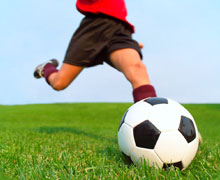Prevent Sports Injuries in Children and Teens
You can download this article as a PDF.
 Sports seasons for kids are getting longer, and the level of play is more intense than it used to be. Many young athletes take part in the same sport nearly all year around. As a result, sports injuries are becoming more common in children and teens. Here are some things that you and your child can do to protect their growing body from getting hurt.
Sports seasons for kids are getting longer, and the level of play is more intense than it used to be. Many young athletes take part in the same sport nearly all year around. As a result, sports injuries are becoming more common in children and teens. Here are some things that you and your child can do to protect their growing body from getting hurt.
How should my child prepare for the season?
Schools and athletic clubs often require an annual sports exam before a child participates. This exam is different from a yearly well-child checkup. It includes sports-related questions and evaluations to make sure your young athlete is ready to compete safely. Make your child’s sports physical appointment for about 6 weeks before the season starts. This will allow time for more tests or follow-up visits, if needed.
Your child should prepare for their sport before the first practice. Make sure they are getting at least 1 hour of exercise each day but aim to have at least 1 day off per week and at least 1 month off per year to allow for rest and recovery. They should slowly build up the length and intensity of exercise to help prevent injuries from increasing activity too quickly. Encourage them to work on certain kinds of exercise that will help them get ready for their sport. For example, if your child is going to play soccer, suggest they start running. Younger kids can start with a few laps around the field or playground and slowly increase the distance. Older kids can start slow and work up to a few miles a couple of times each week.
Stretching the muscles can help keep and increase flexibility, which also helps prevent injury. Check with your child’s coach, athletic trainer or healthcare provider for suggestions of good stretches before the season starts.
Be Ready – Know the Rules and Use the Right Safety Gear
Your child will learn the rules for their sport during practices, but it is a good idea to start learning about the rules and needed sports equipment before the season starts. Discuss with your child that the rules are in place to help keep them safe. For example, rules about tackling in football are in place to help prevent concussions and neck injuries. Rules about pitch count protect the arm and shoulder.
Using the right equipment and safety gear for the sport can lower the chance of getting hurt. Some examples of safety gear are mouth guards, pads and helmets.
Check that your child is playing on safe surfaces. For example, check for basketball pole padding and anchored goalposts. Speak up if you see any issues such as an unsecured base on the field, or water on the court.
Are warm-ups and cool-downs really needed for young athletes?
Yes! Light stretching and jogging before practices and games helps warm the muscles to make them more flexible and prepare them for activity. Cooling down with stretching afterwards helps the muscles recover and helps prevent injuries.
What should I feed my young athlete?
Young athletes need to eat well-balanced meals and snacks, just as we all should. Provide food from each of the food groups – grains, vegetables, fruits, dairy, and meat and beans. Most young athletes will eat the amount of food that their body needs on their own. If you have any questions about how much or what types of food your child should eat, contact their healthcare provider for advice.
Some sports, such as wrestling or gymnastics, have a focus on weight or physical appearance. It can be hard to know if your child is getting enough of the right kinds of food. Talk with your child’s doctor or a nutritionist.
Are sports drinks a good choice?
It is important for kids to drink fluids before, every 20 minutes during, and then after playing. Water is usually best, but a sports drink can be a good choice if your child has been intensely active for more than 1 hour. Sports drinks help replace sodium and potassium lost in sweat. They also provide energy. The downside is that sports drinks contain a lot of sugar, so avoid giving more than 1 to your child in a day.
What if my child feels pain while playing?
Never let your child play through pain or a possible concussion. Kids will often try to keep playing to avoid missing a big game or being seen as weak.
Help your child learn to listen to their body and understand that pain is their body’s way of telling them to rest. Pain can be a sign of an injury, like a sprain. It can also be a sign of a developing overuse injury, such as a stress fracture or growth center injury. A change in your child’s technique, such as a limp when running, throwing differently or rubbing a limb during activity can be signs of injury. Whether the injury is serious or not, growing bodies need to get out of the game when in pain.
Most concussions happen without loss of consciousness. If your child gets a bump or blow to the head or body, watch for symptoms of concussion. Symptoms include headache, balance or vision problems, dizziness, nausea, vomiting or appearing confused, sluggish or groggy.
If you think your child may be injured, take them to a healthcare provider or team athletic trainer as soon as possible. This will help prevent a worse injury, and the provider can help your child get back to their sport in a healthy, efficient manner.
You may want to take your child to a doctor that specializes in sports medicine for children and teens. Some of the evaluations and treatments used for adults are not always right for young, growing bodies. Make sure your child or teen is cleared for participation by a healthcare provider before returning to play.
What else should I know?
It seems obvious, but don’t overlook the benefit of a good night’s sleep. Well-rested athletes perform better and may avoid injury.

